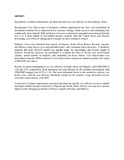GDP matters: cost effectiveness of cochlear implantation and deaf education in sub-Saharan Africa

View/
Date
2015Author
Emmett, Susan
Tucci, Debara
Smith, Magtel
Macharia, Isaac M
Ndegwa, Serah N
Nakku, Doreen
Kaitesi, Mukara B.
Ibekwe, Titus S
Mulwafu, Wakisa
Gong, Wenfeng
Francis, Howard W
Saunders, James E
Language
enMetadata
Show full item recordAbstract
Hypothesis: Cochlear implantation and deaf education are cost effective in Sub-Saharan Africa.
Background: Cost effectiveness of pediatric cochlear implantation has been well established in developed countries but is unknown in low resource settings, where access to the technology has traditionally been limited. With incidence of severe-to-profound congenital sensorineural hearing loss 5 to 6 times higher in low/middle-income countries than the United States and Europe, developing cost-effective management strategies in these settings is critical.
Methods: Costs were obtained from experts in Nigeria, South Africa, Kenya, Rwanda, Uganda, and Malawi using known costs and published data, with estimation when necessary. A disability adjusted life years (DALY) model was applied using 3% discounting and 10-year length of analysis. Sensitivity analysis was performed to evaluate the effect of device cost, professional salaries, annual number of implants, and probability of device failure. Cost effectiveness was determined using the WHO standard of cost-effectiveness ratio/gross domestic product per capita (CER/GDP) less than 3.
Results: Cochlear implantation was cost effective in South Africa and Nigeria, with CER/GDP of 1.03 and 2.05, respectively. Deaf education was cost effective in all countries investigated, with CER/GDP ranging from 0.55 to 1.56. The most influential factor in the sensitivity analysis was device cost, with the cost-effective threshold reached in all countries using discounted device costs that varied directly with GDP.
Conclusion: Cochlear implantation and deaf education are equally cost effective in lower-middle and upper-middle income economies of Nigeria and South Africa. Device cost may have greater impact in the emerging economies of Kenya, Uganda, Rwanda, and Malawi.
URI
http://journals.lww.com/otology-neurotology/Abstract/2015/09000/GDP_Matters___Cost_Effectiveness_of_Cochlear.11.aspxhttp://hdl.handle.net/11295/91605
Citation
Mulwafu, Wakisa, et al. "GDP Matters: Cost-Effectiveness of Cochlear Implantation and Deaf Education in Sub-Saharan Africa." (2015).Publisher
GDP Matters: cost effectiveness of cochlear implantation and deaf education in sub-Saharan Africa
Collections
- Faculty of Health Sciences (FHS) [10415]
